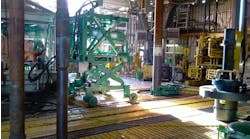Offshore staff
LONDON – Britain’s Department of Energy & Climate Change (DECC) has awarded various licenses in little-explored regions under the 26th seaward oil and gas licensing round.
This second tranche of licenses was delayed pending detailed assessments of the potential environmental impact in these regions.
Among the winners, Providence Resources’ UK subsidiary PR Singleton was offered a frontier exploration license over six blocks in the Rathlin Basin, offshore Northern Ireland.
The initial six-year phase carries a commitment to drill one well. Providence will perform technical studies to review drilling opportunities in the license area.
Australian company Norwest Energy’s subsidiary NWE-Mirrabooka (UK) gained five ‘Promote’ exploration licenses: 98/6b, 98/7b, 98/8, 98/12 (part) and 98/13 (split).
All are in the English Channel off southern England, and are adjacent to Mirrabooka’s two onshore licenses PEDL 238 and PEDL 239.
The company says the concessions are favorably located immediately east/southeast of the Wytch Farm oil field, formerly operated by BP, which at one point produced 110,000 b/d (current levels are nearer 15,000 b/d)
Mirrabooka has so far identified six structural leads with a geological chance of success ranging from 15% to 32%. It will conduct geological and geophysical studies partly based on newly acquired 2D seismic data, with a view to maturing the leads to drillable prospects.
The company has a 65% operating interest in all five licenses, the balance held by Wessex Exploration. If the partners opt to convert the license to ‘Traditional’ status, it will carry a two-year term with a drill-or-drop well commitment.
In the same area, InfraStrata, a gas storage/petroleum exploration company, gained a 50% operating interest in a license covering offshore blocks 97/14, 97/15 and 98/11. These extend more than 584 sq km (225 sq mi) adjoining the Dorset coast, again close to Wytch Farm. The initial license term is for four years with a drilling decision required within the first two years.
CEO Andrew Hindle said: “Within and immediately adjacent to the license area there are a number of active oil and gas seeps.
“A total of seven wells have been previously drilled within the license area, including the first UK offshore well in 1963 on Lulworth Banks in block 97/14. Six of these wells encountered oil or gas shows and three flowed oil or gas on test.”
The most prospective could be the 98/11-2 well drilled in 1984, which encountered a 26-m (85-ft) gas column that flowed 10 MMcf/d on test.
A reservoir engineering study commissioned by InfraStrata suggests this interval could flow a rate above the 40 MMcf/d achieved by the discovery well.
Initially, InfraStrata aims to establish the potential commerciality of this find via onshore development drilling. The program will include reprocessing of existing seismic data to better define the extent and size of the accumulation.
To the east, off the Isle of Wight, NP Solent was awarded part-blocks 98/13 and 98/14. The license is adjacent to parent company Northern Petroleum’s Isle of Wight onshore license, PEDL 240, issued in May 2008.
The new concession includes the offshore extension from PEDL 240 of a prospect mapped prior to 2008 using seismic and well data, and is located in the same petroleum basin containing the Wytch Farm field. However, there is no firm drilling commitment attached to the license award.
Northern acknowledged that the prospect is in an Area of Outstanding Natural Beauty (AONB) and a Heritage Coast, which will impose challenges on field operations.
Among the other awards, Suncor gained a license for blocks 12/26b & 12/27 off the far north of Scotland, in partnership with Noreco.
First Oil won operatorship of blocks 12/16b &12/17b in the Inner Moray Firth off northeast Scotland. According to partner Nautical Petroleum, both exhibit prospectivity in the Lower Cretaceous (Coracle and Punt sandstones) and the Upper Jurassic (Alhess and Claymore sandstones).
The blocks are northeast of the Ithaca-operated Beatrice and Jacky fields and the 12/21-3 discovery. The initial license term is four years with a decision to drill a well required by the end of this period.
Finally, Serica Energy won operatorship of block 110/8b in the East Irish Sea off northwest England. There is a commitment to reprocess 3D seismic to delineate a gas prospect.
In the southern UK gas basin, blocks 47/2b (split), 47/3g (split), 47/7 (split) and 47/8d (part) were offered under a single license to Centrica, with Serica among the partners.
These blocks are immediately adjacent to the York field, also operated by Centrica. Serica says various gas prospects have been identified at both Leman (Permian) and Namurian (Carboniferous) levels, which if proven, could be developed through the York facilities. The work commitments include a 3D seismic survey and reprocessing of existing seismic.
01/05/2012


